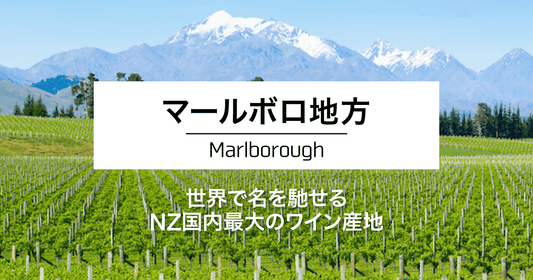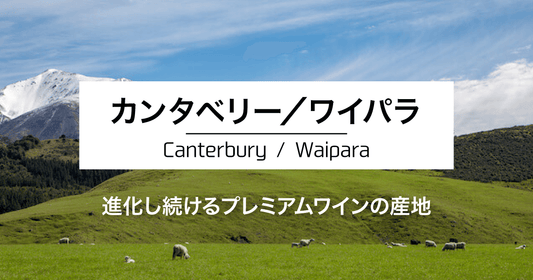
Wairarapa is a wine producing region located at the southernmost tip of the North Island. This region includes an area called "Martinborough" which is known as one of the world's top producers of Pinot Noir.
This region is blessed with beautiful scenery and is easily accessible, just an hour's drive from the capital, Wellington , making it a popular resort destination.

The cultivation area in this region is small, and most producers are small-scale businesses, so production volume accounts for only about 1% of New Zealand's total.
However, it is known as a famous wine-producing region that produces rare wines such as "premium wines" and "cult wines."
Let's explore the appeal of Wairarapa wine.
Climate and soil characteristics of the Wairarapa and Martinborough
"Wairarapa" means "land of shining water" in Maori, and as its name suggests, it is a region rich in nature.
As mentioned at the beginning, the red wine "Pinot Noir" produced in the "Martinborough" area of this region has earned high praise around the world.
This region has three distinctive features:
- The sub-region "Martinborough" is particularly famous.
- The temperature difference in one day is extreme
- Low precipitation and well-drained soil
Let's take a closer look.
"Martinborough" is more famous than "Wairarapa".
New Zealand's wine producing areas are divided into larger areas called "regions", each of which is further divided into smaller areas called "sub-regions" .
Usually, the larger the area, the more well-known it is, but the Wairarapa region is an exception. In terms of recognition, Martinborough is more well-known than the Wairarapa .
It all started in the 1970s, when a government geological survey was started at the request of Montana, a major winery at the time. Soil scientist Dr. Derek Milne announced that "Martinborough's soil, temperature and precipitation are similar to those of Burgundy" and it became clear that the area was suitable for growing grapes.
However, the land available for grape cultivation in Martinborough was too small, so the company chose the second place recommended by Dr. Milne , the Marlborough region, as the development site. After that, in 1978, Dr. Milne's soil report was made public, and people who were interested in the data began making wine in Martinborough.
Today, the Marlborough region has become one of New Zealand's largest wine-producing regions, and Martinborough has become a premium wine-producing region that produces rare and highly valued wines.
So that's how it happened!
Martinborough produces Pinot Noir that is comparable to that of Burgundy. However, compared to Burgundy, there are many wines with a high cost performance, so it is a recommended producing area for those who want to enjoy authentic Pinot Noir at an affordable price.
Temperature variations within a day are favorable for Pinot Noir
The climate in the Wairarapa region is characterized by cool springs and large daily temperature differences in summer. Specifically, the average summer high temperature is 30°C, but it drops sharply at night, with the average low temperature being 12°C, making it quite chilly.
These extreme temperature changes within a day are ideal for growing Pinot Noir. They allow the early-ripening grapes to mature slowly, and the cool autumn weather allows for late harvesting, resulting in grapes with high sugar content.
On the other hand, it is the cold season from winter to spring that is a major problem for producers. To prevent frost from forming on the grapes, they use sprinklers and other measures.
Low precipitation and well-drained soil
The Wairarapa region has high mountains that block rain clouds, resulting in an annual rainfall of only 600-700mm. Tokyo's annual rainfall is around 1,500-1,800mm, so this is less than half of Tokyo's.
Furthermore, the soil in this region is characterized by its good drainage, with a lot of small stones such as gravel. So-called "poor soil" with little moisture and nutrients in the ground is ideal for growing grapes. This is because grape trees seek nutrients to survive, so they spread their roots deep into the ground and try to absorb moisture and nutrients. And because they store nutrients in the "fruit" rather than the branches and leaves, the sugar content is much higher.
"Poor soil with good drainage" is an essential condition for producing grapes with high sugar content!
I didn't know this - I thought vegetables and fruits needed lots of water and fertilizer...!
When you think of Wairarapa, you think of Pinot Noir, but also other grape varieties.
The most famous grape variety in this region is the red wine grape, Pinot Noir .

Pinot Noir is known as a difficult variety, but the Wairarapa region, which has a climate and soil similar to that of its native Burgundy, produces high-quality wine.
Fragrant white wine grapes are also popular.
What are the characteristics of red wine grapes?
The grapes grown in this region are characterized by their thick skins, rich acidity, and full body with a rich flavor. As a result, Pinot Noir, which is known for its bright color among red wines, is darker in Wairarapa. The aromas include plum, chocolate, and even a gamey aroma.
What are the characteristics of white wine grapes?
Apart from Pinot Noir, most of the grapes grown here are for white wine, with the lineup focusing on fragrant wines that take advantage of the cool climate of the Wairarapa region.
The main varieties are:
- Sauvignon Blanc
- Pinot Gris
- Chardonnay
- Riesling
Kusuda Wine , a world-famous Japanese winery in the region, is renowned not only for its Pinot Noir but also for its Riesling.
Wineries in this region
Many of the wineries in the Wairarapa region are concentrated in a small area called "Martinborough Terrace" within Martinborough. Here we introduce four wineries that are essential to any discussion of this region.
Dry River
Dry River is a long-established winery that is revered as legendary among Pinot Noir producers.
Founded in 1979 by Dr. Neil McCallum and his wife, the estate is said to have begun by planting white wine grape varieties such as Pinot Gris in the riverbed that was created when an actual river called the Dry River shifted by 1 km.
Dr. Dry River is a scientist from Oxford University who cultivates grapes from a scientific point of view. Dry River wines are so rare that they are difficult to obtain even in New Zealand.
Ata Rangi
Ata Rangi is a five-star winery known for its Pinot Noir and has won numerous awards both at home and abroad. It was founded in 1980 by Clive Paton and his wife, along with three others, on the poor soil of Martinborough.
Ata Rangi, whose name means "dawn sky, new beginning" in Maori, is a pioneer in Martinborough, and the Pinot Noir they produce is even called "New Zealand's Romanee-Conti."
All wines are fermented using wild yeasts and some vineyards are managed biodynamically .
Martinborough Vineyards
Martinborough Vineyard, a pioneer in New Zealand, was founded in 1979 by Dr. Derek Milne, who was in charge of a geological survey.
In 1997, it won the Bouchard-Van Layson Trophy, awarded to the world's best Pinot Noir, at the International Wine Challenge in London.
Martinborough Vineyard's Pinot Noir is so similar to wine made in the Grand Cru vineyards of Burgundy, France, that it is even called " Screwcap Richebourg (Grand Cru vineyard)".
Kusuda Wines
"Kusuda Wines" is the most famous Japanese winery in New Zealand. The owner, Hiroyuki Kusuda, was influenced by his wine-loving older brother and decided to become a winemaker. He studied oenology at a university in Germany, and immediately after graduating in 2001, he visited Martinborough and established a winery.

Mr. Kusuda is the first Japanese person to make wine in New Zealand.
Kusuda Wines has received high praise both at home and abroad, and was ranked 8th in the 2020 New Zealand Top Wineries, led by Bob Campbell , a Master of Wine and an authority on New Zealand wine!
It's amazing that a Japanese person has made it into the top 10 wineries in New Zealand!!
The wine that Kusuda Wines focuses on is Pinot Noir. It is said to be a difficult wine to obtain because only a small amount is available on the market. Other popular varieties include Syrah and Riesling.
Wairarapa sub-region
The Wairarapa region is made up of three sub-regions :
- Martinborough
- Gladstone
- Masterton

There are three sub-regions, but most of the wine in the Wairarapa region is produced in Martinborough, so you only need to remember Martinborough!
The name is similar to "Marlboro" (laughs).
That's right (laughs). There are other production areas in NZ with similar names, so it can be a little confusing.
Marlborough is a major producer in New Zealand.
A famous wine region in the Martinborough-Wairarapa region.
Please remember this.
The other two sub-regions are still less well known, and are often referred to as "Wairarapa." However, there is no doubt that these areas are suitable for growing grapes, and we can expect great things from them in the future.
Let's take a look at the characteristics of the three areas, focusing on Martinborough.
Martinborough

Martinborough is a small town with a population of just 1,500 people located 55km northeast of the capital, Wellington. It is home to many small wineries producing high-quality wines.
The area is also a popular short getaway destination, bustling on weekends with people looking to enjoy fine wine and food.
Martinborough Terrace
This area, called "Martinborough Terrace", is 4km long and 2km wide at its widest point. It was formed when the Huanarua (Hanagra) River shifted about 1km northward more than 20,000 years ago. It is an area with extremely good drainage, so the fields of popular wineries are densely packed together.
Gladstone

Gladstone is located northeast of Martinborough.
There is also a Japanese-run winery called "URLAR" here. URLAR was started when the previous owner, Angus Thomson, handed it over to his friend, Nishi Yoichiro, the eighth-generation owner of Nishi Sake Brewery in Kagoshima Prefecture.
Currently, Koyama Kohei, who runs a winery called Green Songs in the Nelson region, is the head wine maker, and the grapes are grown using biodynamic farming methods, which show the utmost respect for nature.
Masterton

Masterton is the most populated area in the Wairarapa region and has a popular spot called 'Alpaca Place' where you can interact with the animals.
How to enjoy Martinborough wine
"Martinborough" is a region with a long history of wine in New Zealand, and is popular among tourists and wine fans because you can enjoy wine along with the scenic views. Here, we will introduce "winery tours" and "wine festivals" as ways to enjoy wine in this region.
Tour popular areas around wineries by bicycle
If you want to tour the wineries in this area, we recommend the area called "Martinborough Terrace," where wineries are particularly concentrated in Martinborough. There are also many cellar doors, which are tasting and direct sales outlets, so you can easily visit the wineries.
A bicycle will allow you to visit multiple wineries efficiently. You can rent one at a bicycle rental shop for around 3,000 yen!
Touring wineries by bicycle sounds great! Drinking wine in the great outdoors must be something special.
Toast Martinborough
In November, there's Toast Martinborough , a wine festival where visitors enjoy music, wine and local produce such as oysters.
The word "toast" also means "Cheers!" and the event is held to celebrate and enjoy the wines of the region. During the festival, nearly 8,500 liters of wine are consumed per day.
Wairarapa Wine Harvest Festival
The Wairarapa Wines Harvest Festival takes place in March.
Visitors enjoy comparing wines from each winery, sampling local food, and dancing in the festivities.
▶ Wairarapa Wine Harvest Festival website
Access and tourist information
The Wairarapa region is about an hour's drive from the capital, Wellington. We will focus on providing information on access and sightseeing in Wellington, which is the base for travelling around this region.
How to get to Wellington
There are no direct flights from Japan to the capital, Wellington, so you will need to stop via Auckland on the North Island or Queenstown on the South Island.

The travel time from each region is as follows:
| Auckland (North Island) | Queens Town (South Island) | |
|---|---|---|
| plane | Approximately 1 hour and 5 minutes | Approximately 1 hour and 20 minutes |
There is a convenient bus service from the airport to the city center, which takes about 20 to 30 minutes.
Wellington, the capital of New Zealand

Although Wellington is the capital, its population is only about one-third that of Auckland (about 410,000 people).
In 1865, the capital was moved from Auckland to Wellington, which is close to the South Island, in time for the South Island gold rush. It is also called "Windy Wellington" because of the strong winds that blow in from the straits. Popular tourist spots include Mount Victoria, which overlooks the city of Wellington, and De Papa, the country's largest national museum where you can learn about New Zealand's history.
There are cafes all over the city, where you can enjoy a "flat white," a drink that originated in New Zealand, made by pouring finely frothed steamed milk over espresso.
Wellington is also known as the "Movie City," with a particularly thriving film and arts industry. In recent years, it has been nicknamed "Wellywood" instead of "Hollywood," and its Hollywood-inspired billboards have been a hot topic. Weta Digital , known for producing films such as "The Lord of the Rings" and "The Hobbit," and for its special effects in "Avatar," is also a Wellington-based company. Tours of filming locations are also popular, and the entire city is helping to boost the film industry.
summary
The Wairarapa region is a popular wine-producing region that is also a resort area near the capital, Wellington. Although the region does not produce much, the Pinot Noir from the subregion, Martinborough, is highly regarded among wine lovers.
Burgundy is the birthplace of Pinot Noir, but the price of authentic Pinot Noir there is the highest in the world and tends to be quite high. On the other hand, Wairarapa wines, which are thought to have a climate and soil similar to Burgundy, are of high quality but are more affordable than Burgundy.
The wines from Wairarapa, especially Martinborough, are of very high quality and definitely worth trying!






